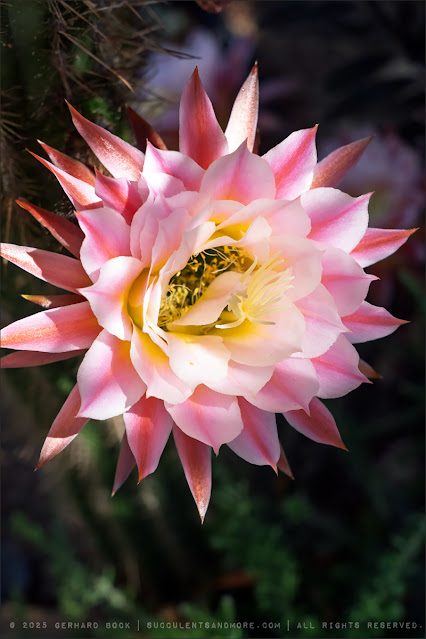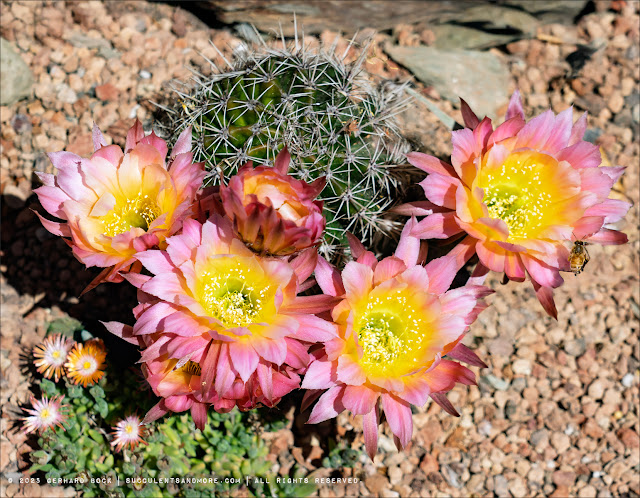May 2025 echinopsis megabloom
Last month, Echinopsis ‘Flying Saucer’ produced a spectacular flower show. Check out this post if you missed it. Since then, I’ve been anxiously watching the flower buds on many other echinopsis hybrids get bigger and bigger. There were a few sporadic flowers, but no grand spectacle. Until Thursday, May 8. That’s when not two, not five, not ten, not fifteen, but eighteen different hybrids burst into bloom.
Southern California cactus breeder Brent Wigand, my source for many of these hybrids, posted videos of his 2025 May Day Megabloom just last week (you can watch them on his Instagram page, here and here). It looks like I finally had a megabloom of my own.
Most of the action was on May 8, but a few (like ‘Flying Saucer’ and ‘Pink Stripes’) stayed open for a second day or produced additional flowers on the second day. Others (like my second specimen of ‘Super Apricot’) didn’t flower until May 9.
I took a lot of photos, starting in the morning when the cacti were still in the shade, and continuing into the afternoon. Some flowers look noticeably different in the shade vs. full sun. In the shade, the colors tend to be much softer, with pastel tones dominating. In the sun, they get a lot punchier. I was trying to represent the flowers as accurately as possible, which isn’t always easy because each display is a little different. But none of the photos below are filtered or artificially saturated; all I did was increase the contrast when the lighting was too flat.
 |
| Echinopsis ‘Flying Saucer’ on May 8 |
- Echinopsis ‘Apricot Glow’
- Echinopsis ‘Celeste’
- Echinopsis ‘Diehl’s Hybrid’
- Echinopsis ‘Dream Catcher’
- Echinopsis ‘First Light’
- Echinopsis ‘Flatty Cake’
- Echinopsis ‘Flying Ice Cream’
- Echinopsis ‘Flying Saucer’
- Echinopsis ‘Flying Serape’
- Echinopsis ‘For Norma’
- Echinopsis ‘Napaea’
- Echinopsis ‘Pink Stripes’
- Echinopsis ‘Salmon Queen’
- Echinopsis ‘Sex on the Beach’
- Echinopsis ‘Shades of Bourne’
- Echinopsis ‘Super Apricot’
- Echinopsis ‘Tondelayo’
- Echinopsis ‘Wessner 368’
I decided to present them in alphabetical order, just because.
Note on taxonomy: There’s a lot of confusion/arguing/griping about Echinopsis vs. Trichocereus. Technically, Echinopsis (and Echinopsis hybrids) are fairly small globe-shaped cacti, while Trichocereus (and Trichocereus hybrids) form tall columnar stems. Trichocereus was lumped into Echinopsis in 1974. In 2012, genetic analysis found that the two genera have divergent lineages, meaning they’re not as closely related as once thought. As a result, Trichocereus was restored as a genus, and it would be more correct taxonomically to refer to hybrids like ‘First Light’ and ‘Flying Saucer’ as Trichocereus. But often the parentage is murky and most likely involves both Echinopsis and Trichocereus (or even other genera), so for the sake of convenience I continue to refer to all of them as Echinopsis hybrids.
Echinopsis ‘Apricot Glow’
Hybridizer: Mark Dimmitt, USA
Flower size: 4-5 inches
Note: to 2 feet in height
 |
| Echinopsis ‘Apricot Glow’ in the back on the right, ‘Flying Saucer’ and ‘Flying Serape’ (bloomed out in front |
 |
| Echinopsis ‘Apricot Glow’ |
 |
| Echinopsis ‘Apricot Glow’ |
Echinopsis ‘Celeste’
Hybridizer: Bob Schick, USA
Flower size: 3-4 inches
Note: See https://media.huntington.org/Schick/hybrids/celeste.html
 |
| Echinopsis ‘Celeste’ in the shade |
 |
| Echinopsis ‘Celeste’ in the sun |
Echinopsis ‘Diehl’sche Hybride’
Hybridizer: Diehl, Germany
Flower size: 4-5 inches
Note: Echinopsis candicans × Echinopsis eyriesii var. grandiflora
 |
| Echinopsis ‘Diehl’sche Hybride’ |
Echinopsis ‘Dream Catcher’
Hybridizer: Brent Wigand, USA
Flower size: 6 inches
 |
| Echinopsis ‘Dream Catcher’ |
 |
| Echinopsis ‘Dream Catcher’ |
 |
| Echinopsis ‘Dream Catcher’ |
Echinopsis ‘First Light’
Hybridizer: Mark Dimmitt, USA
Flower size: 5 inches
Note: Echinopsis ‘First Light’ was created by Tucson plant breeder Mark Dimmitt. It’s a cross between two other hybrids: ‘Diehl’sche Hybride’ (Echinopsis candicans × Echinopsis eyriesii var. grandiflora) and ‘Newlands Orange’ (Echinopsis huascha ‘Gold’ × Echinopsis huascha ‘Red’). My ‘Diehl’sche Hybride’ also flowered (see above).
 |
| Echinopsis ‘First Light’ |
 |
| Echinopsis ‘First Light’ |
 |
| Echinopsis ‘First Light’ |
 |
| Echinopsis ‘First Light’ |
 |
| Echinopsis ‘First Light’ |
 |
| Echinopsis ‘First Light’ |
Echinopsis ‘Flatty Cake’
Hybridizer: Bob Schick, USA
Flower size: 4 inches
Note: See https://media.huntington.org/Schick/hybrids/flattycake.html
 |
| Echinopsis ‘Flatty Cake’ |
Echinopsis ‘Flying Ice Cream’
Hybridizer: Unknown
Flower size: 5 inches
Note: hybrid with ‘Flying Saucer’
 |
| Echinopsis ‘Flying Ice Cream’ |
Echinopsis ‘Flying Saucer’
Hybridizer: Hans Britsch, USA
Flower size: 6-9 inches
Note: ‘Flying Saucer’ is a hybrid between an unidentified Soehrensia species and Trichocereus schickendantzii. It was created by Hans Britsch at his nursery, Western Cactus Growers, in Vista, California. ‘Flying Saucer’ is by far the best known and most popular Echinopsis/Trichocereus hybrids.
 |
| Echinopsis ‘Flying Saucer’ |
 |
| Echinopsis ‘Flying Saucer’ in the shade |
 |
| Echinopsis ‘Flying Saucer’ in the shade |
 |
| Echinopsis ‘Flying Saucer’ in the sun |
 |
| I think they flowers end up being smaller when there are multiples and they’re squished together. But they’re always impressive. |
Echinopsis ‘Flying Serape’
Hybridizer: Brent Wigand
Flower size: 6-7 inches
Note: ‘Flying Saucer’ × ‘Serape’
 |
| Echinopsis ‘Flying Serape’ |
 |
| Echinopsis ‘Flying Serape’ |
Echinopsis ‘For Norma’
Hybridizer: Bob Schick, USA
Flower size: 5 inches
Note: See https://media.huntington.org/Schick/hybrids/for_norma.html. For some reason, the flowers on ‘For Norma’ didn’t open fully. Last year they did (see here).
 |
| Echinopsis ‘For Norma’ |
Echinopsis ‘Napaea’
Hybridizer: Bob Schick, USA
Flower size: 3-4 inches
Note: See https://media.huntington.org/Schick/hybrids/napaea.html
 |
| Echinopsis ‘Napaea’ |
 |
| Echinopsis ‘Napaea’ |
Echinopsis ‘Pink Stripes’
Hybridizer: Reinhard Liske, Germany
Flower size: 6 inches
Note: ‘Wörlitz’ × ‘Cantora Gelb’. It took a few years, but it finally flowered. Definitely worth the wait and my favorite echinopsis hybrid at the moment.
 |
| Echinopsis ‘Pink Stripes’, day 1, with ‘Sex on the Beach’ to the right |
 |
| Echinopsis ‘Pink Stripes’, day 1 |
 |
| Echinopsis ‘Pink Stripes’, day 1 |
Echinopsis ‘Salmon Queen’
Hybridizer: Harry Johnson, USA, USA
Flower size: 3-4 inches
Note: The specimen below had 30 (!) flowers open at the same time
 |
| Echinopsis ‘Salmon Queen’ |
 |
| Echinopsis ‘Salmon Queen’, with Clarkia amoena behind it |
 |
| Echinopsis ‘Salmon Queen’ |
Echinopsis ‘Sex on the Beach’
Hybridizer: Klaus-Peter Mügge, Germany
Flower size: 5-6 inches
 |
| Echinopsis ‘Sex on the Beach’ |
 |
| Echinopsis ‘Sex on the Beach’ |
Echinopsis ‘Shades of Bourne’
Hybridizer: Southfield Nurseries, UK
Flower size: 3-4 inches
Note: Southfield Nurseries in Morton, Lincolnshire has created dozens of echinopsis hybrids named after the nearby town of Bourne. I have just this one, ‘Shades of Bourne’. The Southfield hybrids not only have spectacular flowers, they’re also spectacularly difficult to find in the U.S.
 |
| Echinopsis ‘Shades of Bourne’ |
 |
| Echinopsis ‘Shades of Bourne’ |
 |
| Echinopsis ‘Shades of Bourne’, with ‘Tondelayo’ on the left |
Echinopsis ‘Super Apricot’
Hybridizer: Anton Maas, Germany
Flower size: 5 inches
Note: A hybrid between ‘Apricot’ × ‘Super Gelb’. The flowers are spectacular and have serrated leaf edges – sometimes more pronounced, sometimes less.
 |
| Echinopsis ‘Super Apricot’, specimen 1 – the flower is darker and doesn’t have a lot of serration |
 |
| Echinopsis ‘Super Apricot’, specimen 2 – the flowers are lighter and beautifully serrated |
 |
| Echinopsis ‘Super Apricot’, specimen 2, shade |
 |
| Echinopsis ‘Super Apricot’, specimen 2, sun |
Echinopsis ‘Tondelayo’
Hybridizer: Bob Schick, USA
Flower size: 4 inches
Note: See https://media.huntington.org/Schick/hybrids/tondelayo.html
 |
| Echinopsis ‘Tondelayo’ |
 |
| Echinopsis ‘Tondelayo’, with ‘Shades of Bourne’ on the right |
Echinopsis ‘Wessner 368’
Hybridizer: Andreas Wessner, Germany
Flower size: 3-4 inches
Note: Andreas Wessner’s website: https://kakteen-shop.com/
 |
| Echinopsis ‘Wessner 368’ |
I also put together a five-minute video of my megabloom:




One and all, they are absolutely gorgeous. I couldn't pick a favorite if I tried. It's interesting how synchronized the floral display was/is. How long do the plants continue to bloom once they get going?
ReplyDeleteEach flower only lasts a day or two, but some (like Flying Saucer) bloom 5-6 times within 2-3 months.
DeleteI was surprised to see Shades of Bourne in your California garden! Fabulous show.
ReplyDeleteI got it from a friend. I'd love to have more of their hybrids, but they're hard to find in the U.S.
DeleteIt is like paradise in your beautiful garden .
ReplyDeleteSo many gorgeous flowers . It is a joy to look at them .
Thanks so much for sharing .
Meta
Thank you for your nice comment!
DeleteWow. What if you'd been gone that day?
ReplyDeleteThat doesn't even bear thinking about.
DeleteGorgeous! Definitely worth cancelling plans to stay home and wait. No, Sorry, can't make it. My cacti are blooming tomorrow. Can we reschedule?
ReplyDeleteI'm interested that so much of these come from Germany. I've just begun to realize that there is much more horticultural expertise there than I'd known about and now I want to learn more. There is a very good line of roses from there also.
I'd definitely have rescheduled appointments if needed!
DeleteGerman hybridizers are on the forefront of echinopsis breeding. They create so many cool hybrids, but very few of them are available here. U.S. import regulations are very strict.
WHAT A POST! I love them. Wish I had a good place for all of them! I thought Diehl's Hybrid was an an American hybridizer. I like that you have posted the hybridzers. So interesting!
ReplyDeleteI wasn't able to figure out who created Diehl's Hybrid, but it also goes by its German name (Diehl'sche Hybride) so I assume it came from Germany.
DeleteThe post that starts What a Post! is me, Gerhard. I don't know what happened!
ReplyDeleteAn astonishing 'fireworks' display, Wowza! The video gives a good sense of placement, I loved it. Do you ever get the urge to create your own hybrid?
ReplyDeleteChavli
These are some of the most spectacular and beautiful flowers I have ever seen. It must have been a spectacular sight.
ReplyDelete